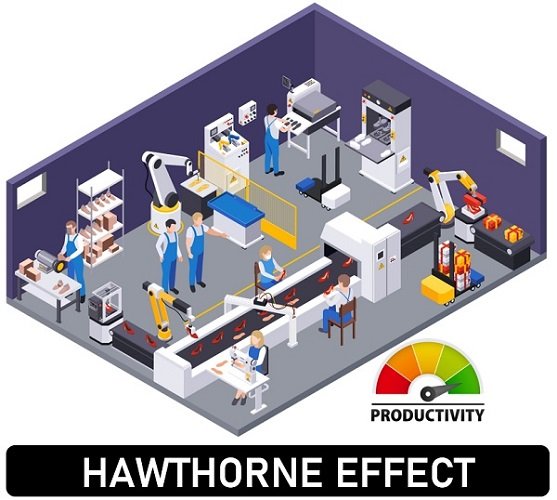Definition: When the participants in the experiment change or improve their behaviour because they come to know that they are under evaluation or observation. Such a change in behaviour is the Hawthorne Effect. So, it is like Human Behaviour Reactivity. More precisely, it states that people modify their behaviour once they become aware that the supervisor is watching them or they are under surveillance.
According to Landberger, the Hawthorne effect is the temporary improvement in the workers’ productivity resulting in a response by the workers. It happens when the workers know that the researcher is watching them while they are working.
It refers to the tendency of human beings to work harder and scale up their performance when they are part of an experiment and are under constant observation. This means that the individuals do change their conduct because of the attention they get from the supervisor.
The Hawthorne Experiment is a phenomenon discovered during an experiment in a factory. The aim of the experiments was to measure how the work environment affects the productivity of the workers.
But out of the blue, the researchers found out that there was an increase in workers’ productivity not because of the environmental changes but due to the awareness that they are under surveillance. So the level of lighting made no difference in their productivity. And the results of the experiment were quite surprising. It revealed that the workers usually work better and harder when they are being observed.
Do you know?
Henry A. Landsberger coined the term ‘Hawthrone Effect‘ in 1958 during the study and analysis of data from the chain of experiments conducted by Elton Mayo between 1924 and 1932 at Western Electric Factory in Hawthorne suburb, Chicago. Hence, the effect is named after the place where the experiments were conducted, i.e. Western Electric’s Hawthorne Works, Hawthorne, Illinois.
Concept of Hawthorne Effect
The word ‘Hawthorne effect’ came into being in relation to Hawthorne studies. The studies are an innovative chain of experiments that began in the 1920s. The study aims to check the impact of working condition variables on the productivity of employees. The experiments conducted during the research are:
- Illumination Experiments (1924-1927): To find out the relationship between the productivity of workers and the work the level of lighting in the plant.
- Relay Assembly Test Room Experiments (1927-1932): To analyse the changes in working conditions, like in work structure or conditions like changes in rest periods, working hours, and other physical conditions in a group of women.
- Mica Splitting Test Group (1928 – 1930): To examine the changes in working conditions, like the introduction of rest periods, elimination of overtime work and modifying a 40-hour week, on the participants.
- Experiments in Interviewing Workers (1928- 1930): To find out the hidden social and psychological factors affecting worker productivity.
- Bank Wiring Room Experiments (1931-1932): To ascertain how payment incentives would impact productivity.
Result of the Experiment
In one of its well-known experiments – Illumination Experiments. The study was carried out to know if the increase or decrease in the amount of lighting at the workplace has any effect on their productivity. In the original study, the workers’ productivity increased both when the lighting was increased and also when the lighting was decreased. However, the workers’ productivity decreased as soon as the experiment was over.
In a similar study, worker productivity increased with the lengthening of work time and reduced work breaks. But then also, the result was the same as before, i.e. as soon as the experiment was over, the productivity levels of the workers were reduced. So, the researchers found that they were responding to the direct attention they received form the supervisor or researcher.
Hence, the researchers concluded that even the minutest change in the experimental conditions of the workers led to an increase in their productivity. For Example, Increase in productivity when the illumination was reduced to extreme levels, when the rest was cut off entirely and also when the working hours were increased.
After these experiments, the researchers observed that the workers were actually responding to the higher attention from the supervisors and not to the changes in the working environment or experimental variables.
Findings of the Hawthorne Effect
- The observation increases employee productivity.
- The circle of your colleagues have a significant impact on your work.
- Gender diversity is essential in the workplace.
- Small changes in work ethics can result in great changes.
A word from Business Jargons
All in all, the Hawthorne Effect is a process where ‘human beings’ who are the participants of an experiment modify their behaviour only because they are being studied.

Leave a Reply